by Joe Domaleski | Oct 30, 2023 | Blog, Business, Columnists, Community, Front Page, News Center, Opinion
It seems a bit ironic that I would write a column about handling stress, especially when I grapple with it myself. Over the years, running a small marketing agency has taught me that the holiday season, while filled with festive cheer and holiday excitement, can also bring its own set of challenges. Balancing client demands, ensuring the team is in high spirits, and dealing with the personal pressures the season sometimes brings, has been a learning journey. Recently, I found myself confronting the “double whammy” of two particularly stressful situations that, admittedly, got the better of me.
In the first situation, a long-time client lied to me. Because I tend to be a trusting person, I couldn’t see the situation for what it was and had to get an outside perspective. “Yes Joe, they lied to you and they did so probably because they didn’t have the heart to handle the situation with you directly,” said my trusted advisor. I kept playing back the situation in my head thinking I had done something wrong or was misreading something. What made the situation more awkward was the fact that some others in the community that I trusted, played along with the deception. Instead of just letting it go, I held on to the situation and stewed over it in my head.
During the same time frame, I had to handle the dismissal of an under-performing team member. We have great employees and in our twenty year history have rarely had to let anyone go. It’s in my nature to seek the best in others, which sometimes blinds me to reality. In this case, we had to make a change after multiple attempts to make things better. Terminating someone’s employment is always a stressful and disheartening task.
Specific sources of stress we face as a small marketing agency include:
- High Client Expectations: Although we pride ourselves on high quality creative services, some clients have expectations that rival those for larger agencies who are operating with bigger budgets.
- Tight Deadlines: I don’t think this is unique to our industry or firm – society is impatient. While quality takes time, most people don’t want to wait which puts pressure on deadlines. We tend to move much quicker than industry averages but that can sometimes create unrealistic expectations.
- Diverse Skill Demands: Even though we’re larger than many other local marketing firms, we’re still a small company. Our employees often wear multiple hats, which can be both rewarding and stressful, especially if they’re stepping into unfamiliar territory. We try really hard to keep business local with local employees – which bucks the trend of outsourcing things overseas.
- Client Dependency: We love all of our clients – large and small. Relying heavily on a few clients for revenue is stressful, as losing just one client can have a significant financial impact. For those of you running organizations with large contracts or grants, you know exactly what I’m talking about.
- Financial Pressures: Managing budgets, ensuring positive cash flow, and dealing with the uncertainties of fluctuating income can be a source of ongoing stress. Probably the biggest challenge facing our business is accounts receivable. The business is coming in, but getting paid for our work is sometimes a challenge.
- Keeping Up with Trends: The fast-paced nature of marketing, with ever-evolving digital platforms and consumer behaviors, means we must continually adapt and learn.
- Scaling Challenges: We’ve struggled with this as do most businesses that are growing. Hiring the right talent, expanding our client base, and remaining true to our hometown base is not easy.
- Client Communication: Again, not unique to my company but managing client expectations, handling feedback, or dealing with difficult clients can be challenging and stressful.
- Dealing with Rejection: Rejection is an inherent part of our industry. Whether it’s a pitch that didn’t win a client over, a campaign idea that was turned down, or a proposal that didn’t secure funding, rejection is disheartening and it’s hard not to take it personally. For small agencies like mine, where every potential client and project can be crucial for growth and sustainability, these rejections can feel even more personal and impactful.
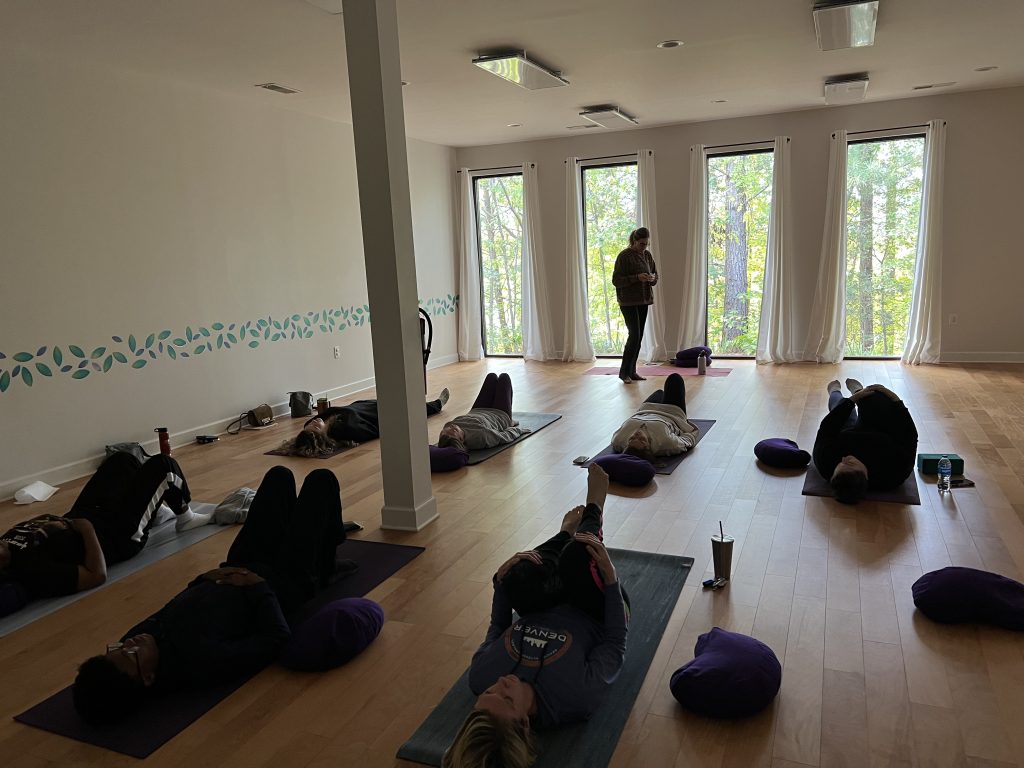
The Country Fried Creative team enjoys a class at Sweet Tea Yoga in Peachtree City. Instructor Tanya Dunne leads the class. Photo/Joe Domaleski
In preparation for the forthcoming holiday season, we dedicated our October company-wide meeting to health, wellness, and specifically, stress management. We conducted our session at Sweet Tea Yoga in Peachtree City. Guided by the expertise of instructor Tanya Dunne, our team engaged in a unique class tailored to enhance our well-being. Although I’ve attended similar Yoga classes myself, this is the first time I’ve participated in one with my co-workers. I highly recommend the shared experience as it shows team commitment to wellness.
Every business, indeed, every person has to contend with stress especially during the holiday season. Last year, I wrote an article entitled, “It’s always darkest before the dawn”, which identified some typical sources of holiday stress along with some general guidance on how to handle them. All of that guidance is still applicable, but for this article I want to focus specifically on keeping calm by letting things go.
In trying to deal with the stressful situations I mentioned above, I came to the realization that I was holding on to negative emotions too long. This self-awareness led me to the Parable of the Glass of Water, which illustrates the importance of letting go of life’s stresses and worries.

Holding a glass of water. Photo/Imago Photo – stock.adobe.com
In the story, a professor holds up a glass of water and asks her students how heavy they think it is. The answers vary, but the professor explains that the absolute weight doesn’t matter. What matters is how long one holds onto it. Holding it for a minute is manageable, but holding it for hours will cause strain and pain, and holding it for days will paralyze one’s arm. The same goes for our stresses and worries. Think of them as the glass of water. Hold onto them for a bit, and they’re bearable. But if we carry them all day, they become burdensome, and holding onto them longer can weigh us down completely. The lesson is to let go of the stresses and not carry them for extended periods.
As leaders, we are often told to be strong pillars for our team, to exude confidence and surety in every decision, and to always be the guiding beacon. Yet, it’s essential to recognize that we too are human, susceptible to the same stresses and strains as everyone else. The Parable of the Glass of Water is a gentle reminder that while challenges and setbacks are inevitable, how we choose to handle them determines their impact on our well-being and those around us. By learning to release these burdens promptly, we not only preserve our mental and emotional health but also foster a nurturing environment where our team feels supported and understood.
As we approach the holiday season, remember to keep calm, let go, and carry on. We got this!
[Joe Domaleski, a Fayette County resident for 25 years, is the owner of Country Fried Creative – an award-winning digital marketing agency located in Peachtree City. His company was the Fayette Chamber’s 2021 Small Business of the Year. Joe is a husband, father of three grown children, and proud Army veteran. He has an MBA from Georgia State University and enjoys sharing his perspectives drawing from thirty years of business leadership experience. Sign up for the Country Fried Creative newsletter to get marketing and business articles directly in your inbox. ]
by Joe Domaleski | Oct 9, 2023 | Blog, Business, Columnists, Community, Front Page, News Center, Opinion
Last Saturday night, I had the pleasure of joining the Flint River Astronomy Club at Lake Horton for ‘A Night Under the Stars,’ sponsored by Fayette County Parks and Recreation. It was a beautiful fall evening, with clear skies showcasing a dazzling array of stars, planets, and galaxies. I was fascinated to see how each amateur astronomer utilized various telescopes and devices to observe the night sky with clarity. They not only set up viewing devices for the public but also shared insights using each other’s equipment. The club engages in public outreach and also serves as a platform for members to learn from one another. One astronomer shared that achieving a clear and complete view of the night sky involves numerous tools and techniques. Being a science nerd myself, I thought astronomy might serve as a fun backdrop to explore the topic of clarity.

A Night Under the Stars from 2022 at Lake Horton. Photo/Joe Domaleski
Astronomy is a celestial science that urges us to gaze upwards and outwards, exploring the universe’s vast, complex systems. Just like astronomers use various tools and work together to explore the starry skies above, business leaders also journey through their own world. The careful watching, ongoing learning, and teamwork shown by the star-gazers can be a helpful picture for business owners and leaders looking to understand their own business world better. They seek clarity amidst a myriad of stars, planets, and galaxies – each symbolizing different facets of their enterprise. Drawing parallels from the cosmos, let’s consider ways that leaders can attain a deeper, richer understanding of their business and the world in which it operates.
Embrace the Cosmic Perspective
- Vastness and Detail: Much like our universe, businesses consist of varied, interconnected elements. Just as astronomers understand both the tiny details of individual celestial bodies and the broader cosmic structures, business leaders must balance a focus on detailed operations with overarching strategic views, recognizing the interplay of diverse business aspects and scale.
- Continuous Exploration: The universe constantly unfolds new mysteries and realms. Similarly, leaders should maintain a stance of continual exploration and learning, ensuring they’re attuned to emerging trends, technologies, and opportunities in their business landscape.
Navigate by the North Star
- Vision as Your Guiding Light: Astronomers use the North Star (Polaris) to navigate the celestial sphere. In like manner, your business vision should serve as a steadfast guide, ensuring every decision and strategy aligns with your ultimate objectives.
- Consistency in Leadership: Much like the consistency of Polaris, maintain a steady, reliable leadership style that guides your team, even amidst the evolving business cosmos.
Understand Your Galactic Cluster
- Interconnected Realms: Our galaxy, among countless others, forms a bound network in the vast universe. Your business, too, exists within a network of markets, industries, and global events. Comprehending these interconnections assists leaders in anticipating shifts and navigating through various external influences.
- Harmony in Diversity: The universe thrives in its diverse, expansive nature. Cherish the diversity within your team, leveraging varied skills and perspectives to foster innovation and resolve challenges creatively.
The Black Holes: Hidden Dangers
- Avoiding Gravitational Pull: Black holes absorb everything that ventures too close. Similarly, leaders must be wary of potential pitfalls that could detract from their path, such as unfavorable deals, toxic business relationships, or unproductive ventures.
- Innovative Escapes: Sometimes, innovative strategies and bold decisions, much like the jets propelling from black holes, can propel your business out of stagnancy and into vibrant, new territories.
Adapt to Cosmic Shifts
- The Expanding Universe: Just as the universe continuously expands and evolves, the business world is in perpetual flux. Adapting to changes, be it technological advancements, market dynamics, or internal developments, is vital to sustainable success.
- Sustainable Transformations: Implement changes that not only address immediate concerns but are also sustainable in the long run, ensuring your business remains resilient amidst future cosmic shifts.
As I was writing this piece, the subject of clarity and clear skies reminded me of this song:
I can see clearly now the rain is gone
I can see all obstacles in my way
Gone are the dark clouds that had me blind
It’s gonna be a bright (bright)
Bright (bright) sunshiny day
– “I Can See Clearly Now” by Johnny nash
Embracing and understanding the vast, interconnected, and inherently mysterious universe of your business, while nimbly adapting to its dynamic nature, lays the foundation for astute and enlightened leadership. As you embark on this starry adventure with your business, may you find abundant opportunities for success, navigate through challenges, and propel your projects into a future that is not only financially prosperous but also vibrant and robust. Here’s to exploring the cosmos of your business with clarity, curiosity, and courage, guiding your team to stellar heights and beyond!
[Joe Domaleski, a Fayette County resident for 25 years, is the owner of Country Fried Creative – an award-winning digital marketing agency located in Peachtree City. His company was the Fayette Chamber’s 2021 Small Business of the Year. Joe is a husband, father of three grown children, and proud Army veteran. He has an MBA from Georgia State University and enjoys sharing his perspectives drawing from thirty years of business leadership experience. ]
by Joe Domaleski | Oct 2, 2023 | Blog, Business, Columnists, Community, Front Page, News Center, Opinion
Rejection is part of life. This past week, I experienced rejection both personally and professionally. Both were isolated incidents, but both situations hurt. Having one’s ideas rejected is difficult and it’s hard not to take that personally. For leaders, each “no” can feel like a roadblock to success. I spent the weekend thinking about rejection to find the upside. Time and reflection do make things better. I realized that with the right mindset, these rejections can become the fuel that propels me and my business to new heights.
Let’s take a look at some common types of rejection and provide some insights on how to handle and learn from them. Here are some common ways people might experience rejection:
- Personal relationships – not having feelings reciprocated from friends, families, and romantic relationships. This is especially true if you’re a “Words of Affirmation” person – look that up, if you don’t know what that means.
- Professional relationships – being passed over for a job offer, promotion, loan application, or acceptance into a professional group.
- Creative endeavors – having creative works rejected by clients or peers.
- Sales – when a prospective new customer chooses not to buy from you.
- Customer relationships – when an existing customer chooses to cancel or not renew a contract.
- Athletic performances – when you lose the game or fail to meet a specific athletic standard.
- Auditions or try-outs – not being selected for a part on a team, play, musical, or other group.
- Social settings – not being included in social groups aka “being left out”.
- Competitions and contests – not winning or advancing in a competitive scenario. This is especially frustrating if you don’t know you’re even in competition until you find out later you were!
Rejection can come in many forms and from various avenues. Here are some ways in which someone might experience rejection:
- Direct Verbal Rejection: Individuals can be straightforward and tell you ‘no’ or express their disinterest directly. This is my preferred way of getting rejected because it’s normally quick and direct. There’s no second-guessing and you can immediately move on.
- Indirect Verbal Rejection: This can be less straightforward, where someone may give vague or non-committal responses which essentially amount to a rejection.
- Non-verbal Rejection: Sometimes people show their disinterest or rejection through body language, like avoiding eye contact or turning away.
- Written Rejection: Rejection can come in the form of a letter, email, or text message, such as a declined job application or a breakup message. Similar to a direct verbal rejection, it’s very direct.
- Online Rejection: Individuals can experience rejection on social media or other online channels through unresponsiveness, unfollows, or even negative comments.
- Passive Rejection: This form of rejection happens when someone ignores your calls, messages, or invitations, essentially rejecting you without a direct confrontation. This is my least favorite form of rejection. See my earlier article about ghosting in the workplace.
- Exclusion: Similar to a passive rejection, this is specifically being left out of gatherings, meetings, or social events. It may or may not be intentional.
- Disapproval: One can also experience rejection through disapproval of their ideas, behaviors, or lifestyles. Although not as straightforward as a direct verbal or written rejection, the intent is usually pretty clear.
- Constructive Criticism: While it’s intended to help, some individuals may interpret constructive criticism as a form of rejection. It’s not easy to take constructive feedback, but the best leaders do and learn from it.
- Comparative Rejection: Being passed over for opportunities in favor of others, whether in professional, social, or personal contexts. This is normally less painful if it’s clear that you’re in competition for something. Comparative rejection when you don’t know you’re in competition is more awkward and frustrating.
Yes, you can see I did a lot of thinking about rejection over the weekend. If you’re dealing with rejection, I know how you might be feel. Each of these types of rejection can be challenging to deal with. However, as I wrote this article it helped me gain perspective. Understanding the nature of rejection and developing coping strategies can lead to personal growth and improved resilience.
Now that we’ve identified some of the situations and ways in which someone might experience rejection. Let’s examine some ways we can handle rejection.
Allow Yourself to Feel the Emotions: It’s natural to feel disappointed or upset after a rejection. Give yourself some time to process your emotions. I did that myself this past weekend.
Avoid Personalizing the Rejection: It’s important to remember that rejection is a part of life and does not define your worth. Try to separate your self-worth from the situation at hand.
Practice Self-compassion: Treat yourself with kindness, patience, and understanding. This isn’t easy to do and I tend to be harder on myself than anyone else. Self-compassion can help you recover and move forward.
Seek Support: Talk to supportive friends, family, or co-workers who can provide a positive perspective.
Learn and Grow: Reflect on the experience and see if there’s anything you can learn from it. Every rejection can be a learning experience to improve and grow.
Keep Trying: Don’t let rejection hold you back. Keep putting yourself out there and pursuing what you desire. Keep networking, improving your skills, and applying for new opportunities.
Maintain Professionalism: No matter the circumstance, it’s essential to remain professional. If given the opportunity, thank the person for their time and consideration.
Ask for Feedback: If appropriate, ask for feedback to understand why you were rejected. This information can be invaluable for improving and growing professionally. It’s not always easy to do, but if the other person opens up the lessons learned may make you even stronger than you would have been had you not been rejected.
Reflect on the Feedback: Take time to reflect on any feedback you receive, and see how you can apply it moving forward. Not all feedback is helpful, nor is rejection always warranted. Indeed, I’ve been in situations where something I proposed was rejected only to see that same idea championed and implemented later. Timing matters.
Develop Resilience: One of my new favor words – resilience. Resilience is a skill that can be built over time. Practice resilience by staying motivated, learning from rejection, and continuing to pursue your goals despite setbacks.

The author Joe Domaleski and his wife Mary Catherine at the Rocket Center in Huntsville, Alabama. They’re probably not thinking about rejection, but this picture does match the title of the article. Photo/Joe Domaleski
Rejection, despite its initial sting, can indeed be turned into rocket fuel propelling individuals towards personal and professional growth when met with a constructive mindset. By acknowledging the emotions tied to rejection, seeking supportive environments, and applying the lessons learned from each experience, individuals can build resilience and gain a deeper understanding of their goals and the pathways to achieve them.
Whether encountered in a personal relationship, a professional setting, or any other domain, rejection is not indicative of one’s worth but rather an opportunity for self-reflection and improvement. The metaphor of turning rejection into rocket fuel means transforming adversity into momentum. With the right perspective and proactive coping strategies, handling rejection becomes a journey of self-discovery and empowerment. By harnessing the energy from rejection, much like a rocket harnessing fuel, individuals can soar to new heights, achieving objectives that once seemed beyond reach.
Writing this article helped me put rejection into perspective and I hope it helps you as well. Keep soaring leaders!
[Joe Domaleski, a Fayette County resident for 25 years, is the owner of Country Fried Creative – an award-winning digital marketing agency located in Peachtree City. His company was the Fayette Chamber’s 2021 Small Business of the Year. Joe is a husband, father of three grown children, and proud Army veteran. He has an MBA from Georgia State University and enjoys sharing his perspectives drawing from thirty years of business leadership experience. ]
by Joe Domaleski | Sep 25, 2023 | Blog, Business, Columnists, Community, Front Page, News Center, Opinion
Iam often asked what it’s like running a business here in Fayette County, Georgia. Although there’s a plethora of articles describing the life of a small business owner, none to my knowledge have delved into the specifics of operating a business in our community. I aim to amend that with this piece, detailing “a day in the life of a Fayette County small business owner.” Although a lengthy read, I hope it provides an enjoyable insight into our local business landscape.
So much of our community’s local work force commutes outside of our county to go to work. When we moved back to the area in 1998, I commuted north to Atlanta as well. Unless you are lucky enough to work for one of the large employers in the community, most of the higher paying jobs were and still are located up in Atlanta. That comes with a cost and for me the cost was business travel. In my very first column, I shared about how the motivation to be home more was one of the reasons I started my business.
I own and operate a digital marketing agency. We are a service-oriented business, differing significantly from retail or restaurant enterprises. This is an important distinction to bear in mind while reading this piece. Although our team is locally based, I’ve adopted a flexible work-from-home policy.
Our primary office is situated in the Westpark area of Peachtree City, a location chosen when I started the business in 2003. Though briefly relocated to north Fayette County, we moved back to Westpark in 2011 and have been there ever since. The office is both welcoming and well-appointed, featuring a fully staffed front desk where clients can receive a professional greeting, or to drop off and pick up items. However, like many service businesses, we operate mostly by appointment. To offer more flexibility to our clients, I recently established a branch office at Trilith in Fayetteville. Unless I have scheduled meetings with clients or staff, my typical work setting is my home, mirroring the arrangement of my employees. I can pretty much do everything I need to do from home, except meet clients.
No two days are identical, but I will try to provide a glimpse of my usual workday, shaped by client projects, employee needs, community involvement, and meetings. Before delving into a day’s narrative, it’s worthwhile to zoom out and understand the broader operational framework shaping my daily activities.
Annually, we set company goals, revisiting and adjusting them quarterly. We convene an “all hands” in-person meeting monthly, sometimes at our offices (Westpark or Trilith), client locations, or occasionally somewhere “fun” to keep the spirit lively.
Every week, I meet with my executive team and separately with our non-executive management team. These meetings, typically conducted via Zoom, help us stay connected and up-to-date. There’s also a weekly operations meeting led by our executives with our employees. Although I am not part of these interactions, it’s heartening to see the business has matured to a level where my presence isn’t needed in every meeting. Our executives excel in managing company operations.
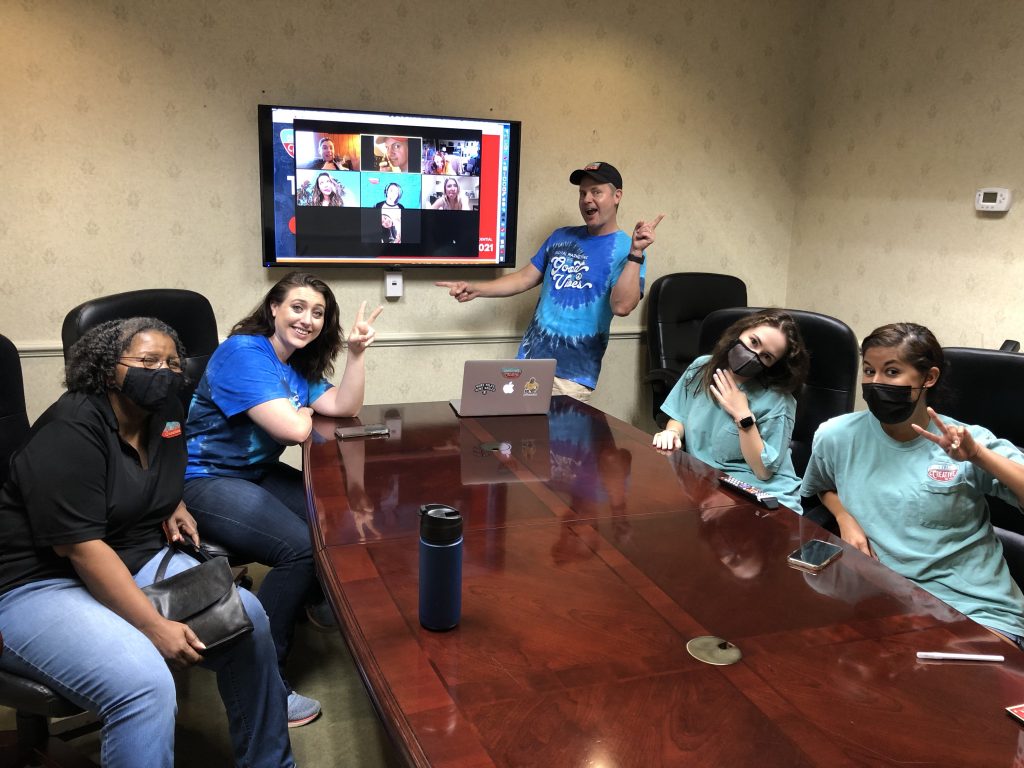
Hybrid team meeting with some staff in our PTC/Westpark office and some online via Zoom during the COVID era. Photo/Joe Domaleski
We rely on two primary business systems, enabling a virtual home base for managing the company. The first is a client ticketing system feeding into our help desk system, facilitating thoughtful customer service. Many businesses merely shuffle emails around, but our ticketing system helps track requests and ensure quality service delivery. Daily, we handle between 10-20 individual requests varying from quote requests, website modifications, technical support to other marketing needs. Most tickets are resolved within 24 hours, with urgent ones receiving immediate attention. The help desk’s inbox can significantly impact the course of a “typical day.” During the COVID era, numerous businesses altered their operational models requiring our assistance to communicate these changes. We set help desk activity records during the COVID period, and it’s gratifying to have helped some many businesses survive. Simply put, the ticketing system allows us to help people more efficiently than if customers contacted individual employees directly.
Our second vital system is our project management/collaboration tool functioning as our virtual office. Powered by Basecamp.com (disclosure: we are their customer, not resellers), this tool facilitates the management of projects, tasks, assignments, documents, schedules, and even provides a platform for interactive communication between team members and clients. It’s a convenient, user-friendly single-source platform accessible via email, web, and phone app. Basecamp predominantly dictates everyone’s workload, and I can view company operations at a macro level or zoom into individual employee tasks. This system significantly contributes to our agility and resilience in adapting to evolving customer needs and circumstances.
On a personal note, I use a separate task management system. In a previous article, I mentioned my affinity for the Getting Things Done (GTD) methodology. I use an application called Things, accessible on my Mac, iPad, and iPhone, for managing both personal and professional tasks. Every Sunday night, I do a weekly review to strategize for the upcoming week, laying out the plan and priorities.
With the aforementioned background, let’s navigate through a “typical day.”

Early morning exercise at Trilith with Mary Catherine. Photo/Joe Domaleski
Early Morning – My wife, Mary Catherine, and I believe in the importance of starting the day early with some exercise. Most mornings see us up by 5 am, heading to the gym or embarking on a brisk walk. This invigorating start ensures other commitments don’t hinder our exercise routine. Post exercise, we have breakfast at home. She drives to her workplace while I commence my workday from home.
Morning – By 7:30 am, I am usually at my computer. Routine checks include the bank account (maintaining a healthy cash flow is vital for small businesses), our financial system, scheduled tasks in Basecamp.com, overnight support tickets (urgent ones alert me via text 24/7), and general email. I sift through these, prioritizing tasks. It’s crucial that I review these BEFORE employees begin their day, allowing for any necessary adjustments in priorities/tasks. Our team enjoys flex hours, with most operating within the core hours of 9 am to 5 pm.
Midday – My meetings are primarily scheduled between 9:30 am to 3:30 pm. Meeting schedules dictate my lunch break and the time slot for tackling pending tasks. On average, I have about 4-5 meetings a day, some brief while others are lengthier. I strive to keep meetings within an hour. At least 2-3 times a week, I plan to have lunch with others. On alternate days, I either eat at home or meet with prospective clients, employees, or other local business associates. If possible, and weather permitting, I try to go outside for some fresh air.
Afternoon – Meetings usually extend into the early afternoon. Subsequent time is devoted to resolving outstanding issues, handling emergencies, consulting with the executive team, and facilitating the smooth flow of operations. I review ticketing and project systems frequently to ensure tasks are on track. By 5:30 pm, I typically wind down my workday, occasionally extending it if crucial tasks remain.
Evening – I make a concerted effort to “clock out” by 5:30pm and encourage my employees to do the same (following our guidance on core hours). Almost every day something pops up from a client at the end of day and after our closing hours. I usually have to make a decision on whether it’s an urgent request that needs immediate attention or something that can wait until morning. Unlike some companies, I try to be firm but not dogmatic about our operating hours to clients. Most clients don’t abuse the privilege of having my personal cell phone. I do answer my phone at all hours if I know who it is.
Some average statistics:
Emails – I usually get around 200-250 emails a day that don’t go to my spam folder, although most are junk. I’d say that at least 50 are worth my attention and only 20 require a direct response.
Phone calls – I usually have about 10 calls I need to personally handle each day. Some are outbound calls that I need to make to follow-up with someone and some are inbound calls where someone needs me. Email and messaging has reduced the need for phone calls.
Meetings – on a “typical day” I have 4-5 meetings. Some are short Zoom check-ins and others are in person office meetings. At least two times a week (but sometimes as many as six times a week) I have an external meeting in the community that’s not directly work related. Sometimes I attend the meetings and sometimes I’m the guest speaker at the meetings.
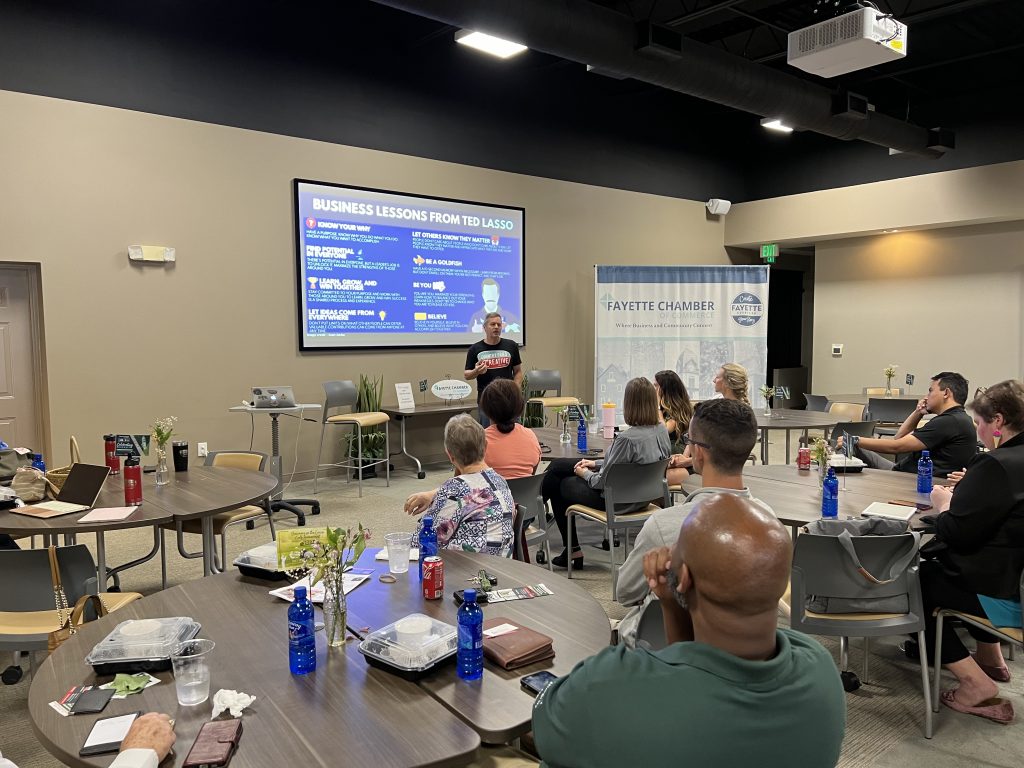
The author Joe Domaleski speaking to the Fayette Chamber on 9/20/23. Photo/Christina Colantonio
Planned vs. unplanned tasks – I’d say about 1/2 of what I do each day is planned and the other 1/2 is unplanned.
If you read through the above “typical day”, there’s probably not a lot that differs from any other small service company. Since we’re talking about Fayette County, Georgia, here’s some things that influence and shape my day that are uniquely local.
- Traffic – although not as bad as driving up in Atlanta, Fayette County has some well known traffic bottlenecks – especially the Hwy 54/74 intersection near my Peachtree City office. As I write this, construction on the data center along Hwy 54 is slowing traffic down dramatically. Bad traffic (regardless of the reason) can increase my time on the road by 50%, even though I live in the county. This impacts my ability to attend meetings and conduct business in the county. Having a good transportation plan is vital to economic growth not just for me, but everyone.
- Community events – one of the joys of owning a local business is the ability to plug into the community and participate in local events – business grand openings, presentations, workshops, networking events, board meetings, and so forth. I participate in several community events a week. The hardest part is deciding which event to attend. I try to plan around them.
- Impromptu drop-ins – because we’re local, sometimes clients like to “drop in”. They’re always welcome to come to our Peachtree City home office, but it’s no guarantee that I’ll be there in person waiting for a visitor. I encourage people to set appointments.
- Interacting with clients in the community – I often joke with customers that I’m inspired to do great work for them because I’ll see them in the community and it’s true. There’s nothing secret in this community of ours and if I don’t do a good job I just might hear about it in the community. The inverse is true and it’s very rewarding to see our work in the community – websites, logos, social media, and other creative works.
- Lack of privacy – that’s one of the downsides of working in the local community. Although it’s not like I’m a celebrity, I do know lots of people and they know me. It’s hard not to run into people I know in the area. That’s mostly a good thing, but sometimes it’s hard to have privacy.
- Competitors – Our local competitors are all great folks and I don’t really feel like there’s a rivalry among us like there is with other industries. We each have our own specialties and, although I can’t speak for them, feel like we all get along just fine. In fact, we rarely compete directly – there seems to be plenty of opportunity for everyone.
- Former clients and employees – Yes, seeing a former client or employee in the community can be a little awkward sometimes. I guess it’s like seeing an ex-boyfriend or ex-girlfriend out in public. We’ve had very little employee turn-over and honestly I can’t think of any bad encounters with former employees. Quite the contrary, it’s great to catch up with them. Regarding customers, I can only think of a handful of “bad encounters” with a former customer in the 20 years I’ve had the business.
- Making an impact – of all the things that influence my day, I think the ability to make an impact in our community is the most important. We work hard to create local jobs, help local businesses, and support local non-profits. Knowing that what we do helps the local community gives me a sense of purpose and I’ll shift my day around as needed to make that happen. Living, working, and raising a family in our community has been my life’s work for the past 20+ years and hopefully for many more years to come.
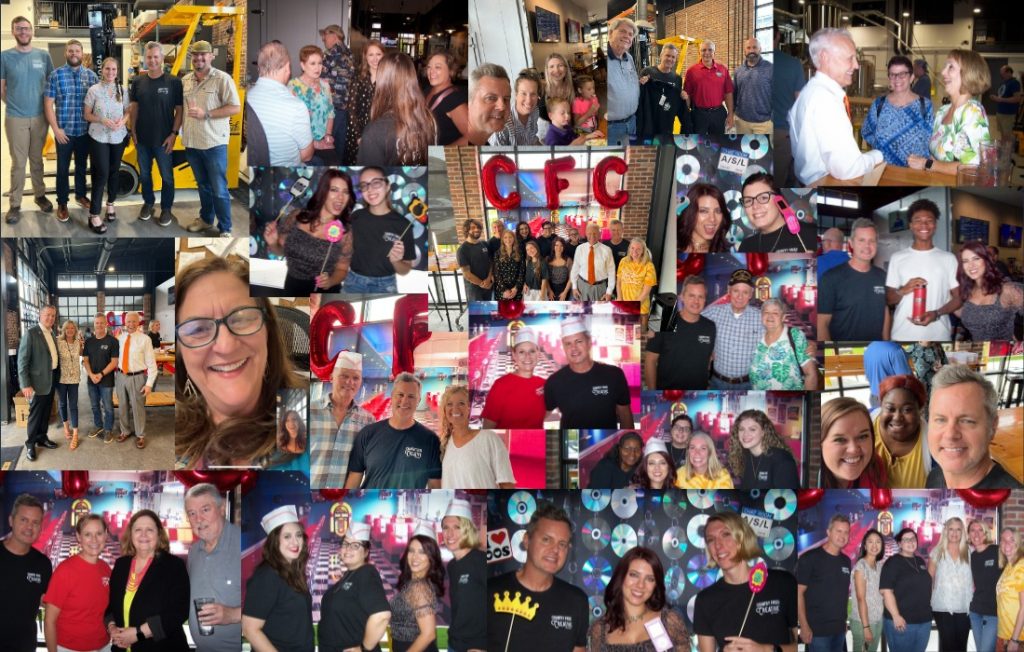
Making an impact. Photo montage from our company’s 20th Anniversary Party in August 2023. Photo/Abby Paver
So, there you have it: a ‘day in the life of a Fayette County small business owner.’ It’s a great life, and I wouldn’t trade it for anything. Many of my college classmates and business associates have either retired early or become executives in large corporations. I decided early on that the big company life wasn’t for me. It’s a blessing to be able to live, work, and play in a small community. Fayette County is large enough for opportunity, yet small enough for developing meaningful relationships with people and making an impact.
[Joe Domaleski, a Fayette County resident for 25 years, is the owner of Country Fried Creative – an award-winning digital marketing agency located in Peachtree City. His company was the Fayette Chamber’s 2021 Small Business of the Year. Joe is a husband, father of three grown children, and proud Army veteran. He has an MBA from Georgia State University and enjoys sharing his perspectives drawing from thirty years of business leadership experience. ]
by Joe Domaleski | Sep 18, 2023 | Blog, Business, Columnists, Community, Front Page, News Center, Opinion
Have you ever watched a promo for a TV series thinking you wouldn’t like it, but then when you actually watch an episode – you love it? Ted Lasso was such a series. During the height of COVID when everyone was at home streaming shows, we fell in love with the Ted Lasso TV series. Debuting on Apple TV+ in 2020, Ted Lasso was the show America needed during COVID.

Ted Lasso on Apple TV+. Photo/Apple
The premise of the “Ted Lasso” series revolves around the character of Coach Ted Lasso, played by Jason Sudeikis. Ted Lasso is an American college football coach who is unexpectedly hired to coach a professional soccer team called AFC Richmond in England, despite having no prior experience with soccer (or football, as it’s known in the UK). Despite the odds stacked against him, Ted Lasso brings his own unique brand of optimism, positivity, and genuine care for people to the team.
Coach Lasso believes in the potential of his players and strives to build a sense of unity and camaraderie among them. The series explores themes of leadership, teamwork, personal growth, and the power of positivity as Ted Lasso and his team navigate the challenges of professional soccer and personal relationships. “Ted Lasso” is known for its heartwarming and comedic storytelling and has been praised for its portrayal of kindness and optimism in a sometimes cynical world.
Besides being a funny show, Ted Lasso offered up a lot of excellent advice. Here are some of my favorites from the show:
“I’ve heard folks say that if you love what you do, you’ll never work a day in your life. Well, I gotta disagree. I love what I do, and I work incredibly hard.”
Despite the “get rich quick” advice on social media, running a business is hard work. I haven’t met a small business owner (and team) who doesn’t work hard. Loving what you do is a fantastic starting point, but it’s the combination of passion and hard work that propels small businesses to achieve their goals and make a lasting impact in their industries. It’s the dedication and effort put into the business that can transform a passion into a successful and thriving enterprise.
“For me, success is not about the wins and losses. It’s about making these young players better people, first and foremost.”
I’ve written previously about how my motivations for running a business have changed. It’s all about our team. Contrary to the suggestion that an owner’s job is to maximize profits, I believe it’s my job to be a good coach for our business team. Yes, it’s my responsibility to manage the financials to ensure our people are well-paid, but it’s more than that. My job as the owner is to create an environment where our team can be the best versions of themselves and get fulfillment in terms of knowledge, leadership, and fulfillment.
“There’s two buttons I never like hittin’, and that’s panic and snooze.”
Uncertainty and challenges are inevitable. Hitting the panic button can lead to hasty decisions that may have detrimental consequences. Similarly, hitting the snooze button by procrastinating or delaying critical actions can hinder progress and growth. Instead, businesses should face challenges with composure. This approach fosters adaptability, innovation, and the ability to navigate complex situations, ultimately contributing to a more successful and sustainable business.
“I promise you, there is something worse out there than being sad, and that’s being alone and being sad.”
The entrepreneurial journey can be incredibly challenging and filled with moments of doubt, stress, and even sadness. Family, friends, co-workers, peers, and professional contacts are all part of your tribe. These connections become a source of strength and shared wisdom, offering guidance, camaraderie, and reassurance. Don’t go it alone.
“Taking on a challenge is a lot like riding a horse. If you’re comfortable while you’re doing it, you’re probably doing it wrong.”
Running a small business or organization is inherently about embracing challenges and stepping out of one’s comfort zone. In fact, it’s been my observation that most stagnation occurs when people get too comfortable with the status quo. Discomfort is a sign of progress and a chance to learn, innovate, and ultimately thrive in a competitive landscape. It reminds us that, in the pursuit of success, embracing the unknown and pushing boundaries can lead to remarkable achievements and personal growth.
“I believe in hope. I believe in believe.”
This is my favorite Ted Lasso quote. Ted Lasso’s unwavering belief in his players, his team, and the power of positivity underpins the entire TV show. This belief isn’t blind; it’s a conscious choice to see the potential in others, to foster unity and camaraderie, and to approach challenges with resilience and hope. One thing I underestimated as I developed our Country Fried Creative team over the years is the need to reinforce the need to “Believe”.
“Believe” teaches us that in sports, business, and life, the power of belief can be a transformative force, capable of turning underdogs into champions and adversity into opportunity. It’s a reminder that in the face of doubt or difficulty, belief in oneself and others can be the catalyst for extraordinary achievements and personal growth.
Coach Lasso, thanks for helping me “Believe”. People think I have all the answers, but I don’t. What I do have is a belief to see the potential in others – team members, clients, and our community. If you’ve seen the TV series Ted Lasso, what are some of your favorite quotes? If you haven’t seen it yet, what are you waiting for?
BELIEVE
[Joe Domaleski, a Fayette County resident for 25 years, is the owner of Country Fried Creative – an award-winning digital marketing agency located in Peachtree City. His company was the Fayette Chamber’s 2021 Small Business of the Year. Joe is a husband, father of three grown children, and proud Army veteran. He has an MBA from Georgia State University and enjoys sharing his perspectives drawing from thirty years of business leadership experience. ]
by Joe Domaleski | Sep 11, 2023 | Blog, Business, Columnists, Community, Front Page, News Center, Opinion
Today is a day of national remembrance. On September 11, 2001, a series of coordinated terrorist attacks occurred in the United States. Do you remember where you were when we were under attack? I do, and it seems like just yesterday. Besides being a day of remembrance, today is also a good day to reflect upon the lessons we learned from 9/11. Many of those lessons apply to your own personal and business preparedness planning.
Although there have been isolated incidents over the years, the attacks on 9/11/01 were the first large-scale attack by a foreign power on the United States mainland since the War of 1812. These attacks are often referred to as “9/11” and had a profound and lasting impact on the country and the world. Our country had to be resilient in order to react and respond to the attack on 9/11.
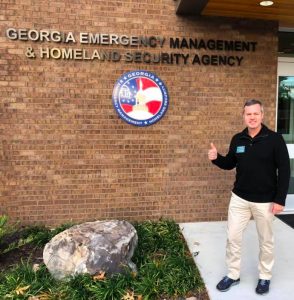
The author (Joe Domaleski) prepares to attend NIMS and ICS training at GEMA/HS HQ in Atlanta. Photo/Georgia AUXCOMM
“Communities across the nation experience a diverse set of threats, hazards, and events. The size, frequency, complexity and scope of these incidents vary, but all involve a range of personnel and organizations to coordinate efforts to save lives, stabilize the incident, and protect property and the environment.” – Introduction from National Incident Management System (NIMS) developed by the Federal Emergency Management Agency (FEMA) and the Department of Homeland Security
NIMS was born In the aftermath of the 9/11 disaster and offers lessons that can be equally applied to government agencies and businesses. It is built on six key principles: 1) Command and Management; 2) Preparedness; 3) Resource Management; 4) Communications and Information Management; 5) Supporting Technologies; and 6) Ongoing Management and Maintenance.
Although not normally as life-threatening, a business has to respond to incidents, threats, and attacks that occur during the normal course of business operations. These may include:
- Cyber attacks
- Theft and fraud
- Natural disasters
- Supply chain disruptions
- Financial challenges
- Reputation damage
- Legal and regulatory problems
- Environmental issues
- Market competition
- Health and safety concerns
- Lack of resources
Not all threats and attacks are deliberate; some manifest themselves in the marketplace as a consequence of doing business. Instead of addressing each threat specifically, let’s apply some lessons in resilience learned from 9/11 by examining NIMS. In addition to that, I’ll incorporate experiences from my time in the US Army and my civilian training in various components of NIMS and the Incident Command System (ICS). I’m going to paraphrase NIMS and ICS principles to apply them in a business context:
- React to the situation appropriately – It should go without saying that when a threatening situation is encountered, it must be addressed. Ignoring a problem does not make it go away. In the Army, we would react to an attack by taking cover and returning fire. In a non-combat emergency situation, appropriate personnel and resources are dispatched to handle it.
- Establish communications – If a robust means of communication is not already in place, it’s important to establish one. In today’s high-tech world, it’s rare not to have a means of communication. Often, the issue is that there are too many communication methods, and it’s not clear when to use each technology. When email and phones go down, how should your employees communicate with you?
- Assess the situation – Gather information about what’s going on, including the nature of the issue, the scope of the situation, and its likely impact on your organization.
- Establish command – Make it clear who will be in charge of handling the situation. Is it you, the business owner? Should you delegate the situation to one of your managers? It’s crucial that everyone knows who will take the lead. In NIMS, we call this establishing an Incident Command. This same principle can be applied in business.
- Create a plan – Based on the situational assessment, the person in charge needs to formulate a plan for handling the situation or threat. The plan should outline objectives, strategies, and tactics for addressing the situation and be flexible enough to adapt to changing circumstances.
- Acquire and manage needed resources – Once a plan is in place, the next step is to acquire and manage any necessary resources, such as staff, technology, communications, financing, and outside assistance.
- Manage operations – Using the plan and allocated resources, the person in charge should effectively oversee the operations involved in addressing the situation. This includes managing communications, collaboration, information management, supervising activities, and resource handling.
- Document and report – The team responding to the situation should document ongoing developments and report progress. Detailed records of incident activities, resource assignments, and expenditures should be maintained. Reporting to stakeholders ensures their buy-in and establishes confidence that the situation is being handled properly.
- Conclude the operation – Once the situation is under control, the organization or team managing it should transition back to a normal pace of operations. Staying on high alert for extended periods is unsustainable. Restore normalcy as soon as possible.
- Evaluate and improve – Take the time to conduct an “after-action review (AAR)” and assess how the situation was handled. Evaluate the response’s effectiveness and identify lessons learned. Use feedback to enhance future response efforts and update response plans as needed.
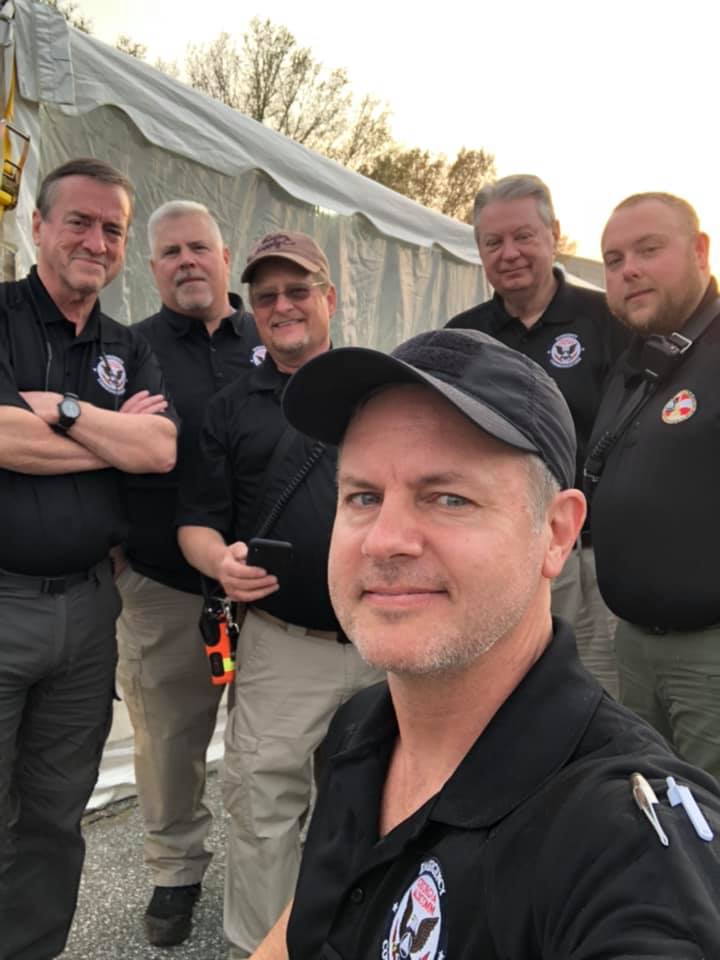
The author (Joe Domaleski) supporting a GEMA/HS communicaions operation as a volunteer. Pictured with (Left-Right) – David Benoist, Joe Martin, Tom Olley, John Davis, and Edwin Whitworth. Photo / Georgia AUXCOMM
NIMS, based on lessons learned from 9/11, reminds us of the power of resilience and the importance of having a well-defined framework for dealing with tough times. This model teaches us to learn from past emergencies and continually enhance our response capabilities. Allow the memory of 9/11 to motivate your business (and personal life) to grow and improve in the face of challenges. We can draw lessons from that day to inspire innovation, strengthen resilience, and strive for excellence, ensuring we are well-prepared for the uncertainties of the future. What are you doing to prepare for unforeseen circumstances and how will you deal with them?
PERSONAL NOTE – In the aftermath of the 9/11 disaster, I decided it was important to have a backup method of communication, so I obtained my FCC Amateur Radio License (aka ham radio). My wife Mary Catherine has her license as well. In order to be in a position to volunteer during incidents, I also received training in NIMS, ICS (Incident Command System), CERT (Community Emergency Response Team), Communications Unit Leader (COML), Communications Unit Technician (COMT), and Auxiliary Communications (AUXC). As a civilian, I volunteer at the local level through ARES (Amateur Radio Emergency Service) and at the state level through the GEMA/HS (Georgia Emergency Management Agency / Homeland Security) AUXCOMM (Auxiliary Communications) program. If you would like to know more about any of these program, feel free to contact me directly – email: ki4ask@arrl.net.
[Joe Domaleski, a Fayette County resident for 25 years, is the owner of Country Fried Creative – an award-winning digital marketing agency located in Peachtree City. His company was the Fayette Chamber’s 2021 Small Business of the Year. Joe is a husband, father of three grown children, and proud Army veteran. He has an MBA from Georgia State University and enjoys sharing his perspectives drawing from thirty years of business leadership experience. ]











